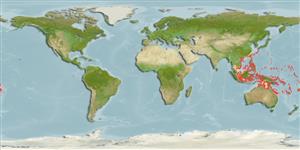Common names from other countries
Environment: milieu / climate zone / depth range / distribution range
Ecologia
marinhas associadas(os) a recifes; intervalo de profundidade 5 - 40 m (Ref. 90102). Tropical; 30°N - 24°S
Pacific Ocean: Viet Nam to Rarotonga (Cook Islands), north to southeastern China and the Ryukyu Islands, south to the Great Barrier Reef and Norfolk Island.
Tamanho / Peso / Idade
Maturity: Lm ? range ? - ? cm
Max length : 10.0 cm TL macho/indeterminado; (Ref. 48636)
Espinhos dorsais (total) : 4; Raios dorsais moles (total) : 8; Espinhos anais: 0; Raios anais moles: 7. Unbranched infraorbital canal, very short upward and downward branches of lateral line. Anal fin dark with many darker spots (Ref. 37424). First dorsal spine is extended with a filament in males. This species has double series of small pearly spots along lower sides (Ref. 48636).
Inhabits coastal bays and estuaries (Ref. 48636), over sand, mud, or dead coral rubble of lagoons and outer reef slopes. Feeds mainly on small benthic invertebrates. Usually buried in substrate. Occurs in small groups (Ref. 48636). May also be solitary (Ref. 90102).
Life cycle and mating behavior
Maturities | Reprodução | Spawnings | Egg(s) | Fecundities | Larvas
Randall, J.E., G.R. Allen and R.C. Steene, 1990. Fishes of the Great Barrier Reef and Coral Sea. University of Hawaii Press, Honolulu, Hawaii. 506 p. (Ref. 2334)
Categoria na Lista Vermelha da IUCN (Ref. 130435)
CITES (Ref. 128078)
Not Evaluated
Ameaça para o homem
Harmless
Utilização humana
Ferramentas
Relatórios especiais
Descarregue XML
Fontes da internet
Estimates based on models
Preferred temperature (Ref.
115969): 24.7 - 28.9, mean 27.7 (based on 300 cells).
Phylogenetic diversity index (Ref.
82804): PD
50 = 0.5039 [Uniqueness, from 0.5 = low to 2.0 = high].
Bayesian length-weight: a=0.00794 (0.00359 - 0.01758), b=2.80 (2.61 - 2.99), in cm Total Length, based on LWR estimates for this (Sub)family-body shape (Ref.
93245).
Nível Trófico (Ref.
69278): 3.5 ±0.37 se; based on food items.
Resiliência (Ref.
120179): Elevada, tempo mínimo de duplicação da população menor que 15 meses (Preliminary K or Fecundity.).
Fishing Vulnerability (Ref.
59153): Low vulnerability (10 of 100).
